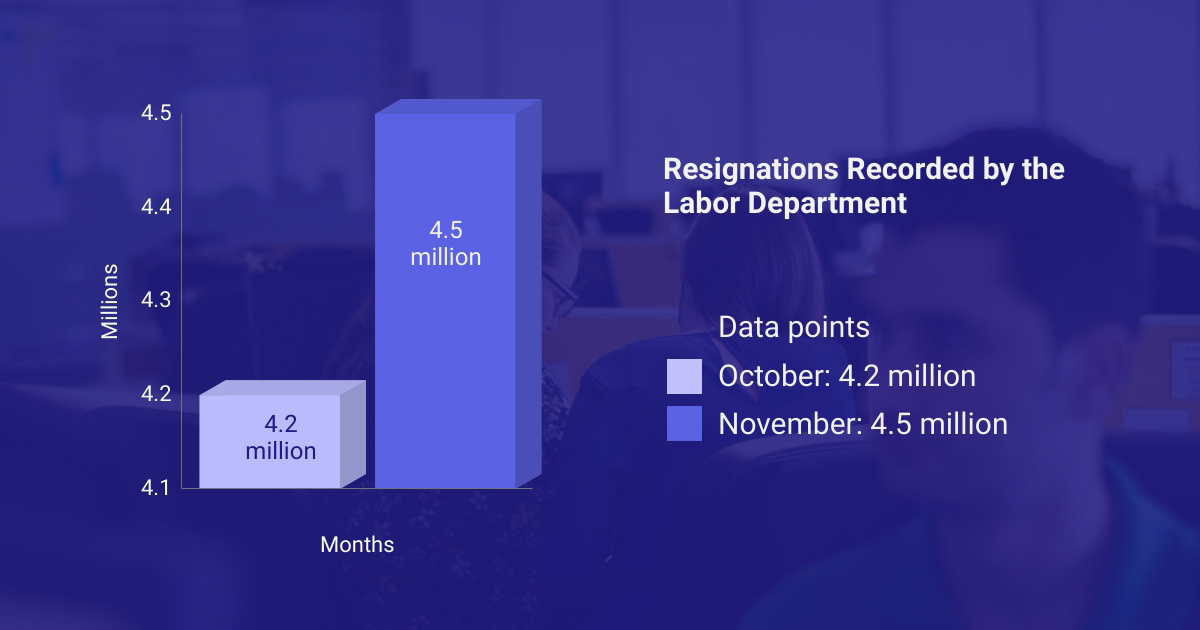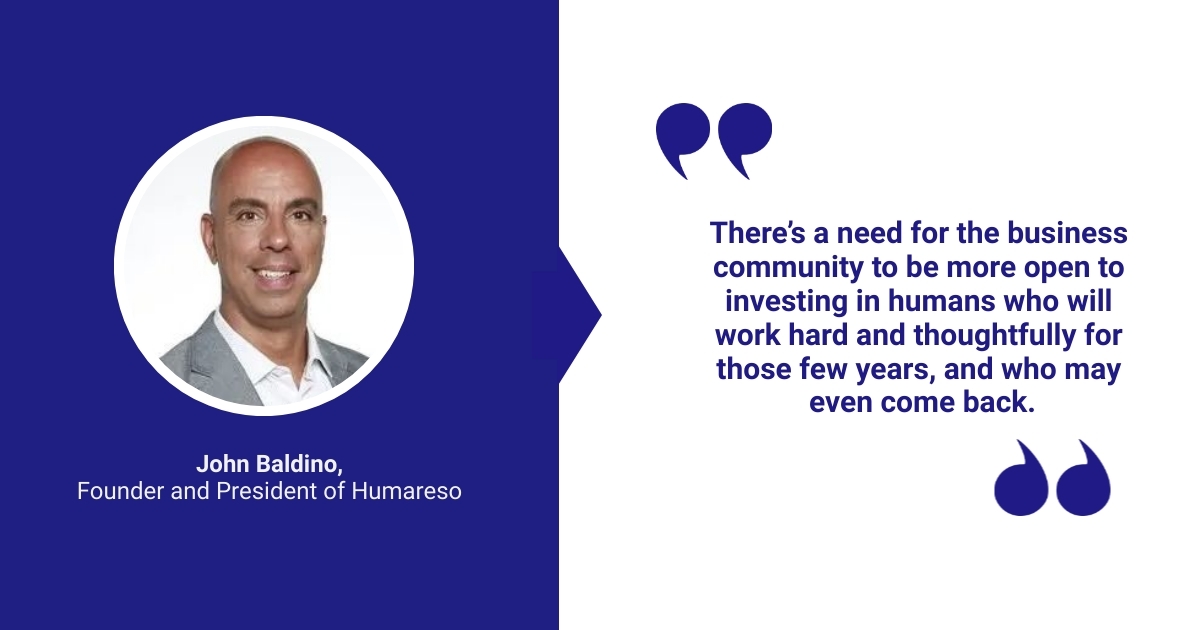Boomerang Employees: Why You Should Rehire Former Talent — and How to Do It

What does “boomerang employee” mean?
It wasn't so long ago that the idea of boomerang employees – workers who leave a company and later return – was a bit of an anomaly.
In fact, there was often a stigma attached to such employees – a perception that they couldn't “make it” outside the cocoon of their former employer.
Some companies can have a tendency to shame former employees as well, as if their departure left a permanent mark on their character and the company would never welcome them again.
They’ve become a hotter topic in recent years, with the Great Resignation resulting in the “Great RegretOpens in a new tab” for some workers who returned to their employers after joining mass resignations in 2020 and 2021.
Trends in talent acquisition have shifted somewhat since this idea first surfaced. While a 2024 survey from Right Management showed that 56% of U.K. employees would return to their previous companies, in reality, boomerang employees accounted for just 4.5% of hires in 2021. That said, that number was up from 3.9% in 2019.
Regardless of the numbers, it’s worth examining the pros and cons of a boomerang employee – as well as questioning ingrown biases about why people leave jobs and what quitting really means.
Why do employees boomerang?
Let’s face it: Despite all good intentions and due diligence, the hiring process — for both the hiring organization and the candidate — is fraught with uncertainty.
Even after an exhaustive interview, extensive screening, and new hire onboarding process, a worker might discover a host of factors in the new job that don’t measure up to their former role.
There are plenty of reasons why a worker might consider returning to their old job, including:
- Unsatisfactory new job experiences
- Lackluster benefits
- Poor workplace culture
- The familiarity and comfort of their previous colleagues and culture
- Lack of career advancement opportunities
- Unstable work environment
- Poor work-life balance
Add it all up, and you’ve got a recipe for a worker to become a boomerang employee.
How common are boomerang employees?
While the trend towards hiring a boomerang employee has grown in recent years, it really took off in 2021 – thanks in large part to the Great Resignation.
Workhuman® iQ polled more than 3,500 workers in the U.S., U.K., Ireland, and Canada to analyze How the Great Resignation Will Shape HR and the Future of Work.
Chris French, Workhuman® executive vice president of customer strategy, pointed out that the accelerated turnover we saw in 2021 occurred largely in service industries, such as hospitality.
As he predicted, the exodus of workers in other industries kicked in, increasing employee turnover at the beginning of 2022.
"We’ve just begun to see the turnover in other jobs by workers who – due to the cumulative effect of not interacting with humans in their company and their team – don’t have the same connection. And they’re leaving." – Chris French
The New York TimesOpens in a new tab reports that more than 4.5 million people voluntarily left their jobs in November 2021, according to Labor Department statistics. “That was up from 4.2 million in October,” the article adds. “And was the most in the two decades that the government has been keeping track.”

And while we’ve seen some easing of the Great Resignation, companies still face the very real risk of losing employees as they navigate policies surrounding the return to physical office space.
An article in The New York TimesOpens in a new tab predicts that, as more companies require workers to return to offices, “It’s either the end of the era of flexibility around where work takes place — or the beginning of outright rebellion.”
What are the benefits of hiring boomerang employees?
Faced with a sudden onslaught of vacancies, HR professionals in 2021 began recruiting former employees in numbers not seen before. There are many reasons why.
Citing research from Cornell UniversityOpens in a new tab, Pavel delineates some of the benefits an organization realizes when it brings back a former employee. The findings show that rehired employees excel at:
- Familiarizing themselves with the social systems that underpin the workings of a company culture
- Navigating hierarchy and processes – especially in large organizations
- Onboarding faster and more effectively, saving on hiring costs
- Often outperforming a new hire – even those with better qualifications
- Acting on existing knowledge and skills
- Being more engaged and more loyal
All of this can add up to improved employee engagement in the workplace, which – let’s face it – is good for everyone.
The report concludes that organizations – especially large ones – should be tapping their alumni network as a source of new talent. Unfortunately, many companies fail to keep track of former workers or maintain good relationships with them.
Against this backdrop, it’s easy to see why the supposed stigma surrounding boomerang employees has lessened significantly. In fact, in today’s tight labor market, some now see hiring previous employees as a smart business strategy.

What are the disadvantages of hiring boomerang employees?
Like any other new hire, a rehired employee doesn’t come without risks.
You need to make sure their intentions are good and that there’s no bad blood between them and anyone at the company. Even small rifts can exacerbate into bigger issues if left unresolved.
There is also a risk that other employees will perceive a sense of favoritism in rehiring the boomerang employee, which could affect team dynamics.
And, of course, there is always the risk that the employee will leave again.
The best way to mitigate these risks is to have a direct, honest conversation with the person in consideration. This kind of conversation doesn’t necessarily call for your average hiring processes. There is no point in being overly polite and skirting around tough questions if you want to ensure a positive and mutually beneficial outcome.
What to consider when hiring a boomerang employee
Hiring a boomerang employee isn’t the automatic “slam dunk” some may think it is. Here are some factors to weigh when considering a boomerang employee:
- Reason for leaving and returning: Why did the worker leave in the first place, and why do they want to return? Any lingering issues or resentments have the potential to build into a larger problem, so be sure the person is on good terms with both their past colleagues and the company at large.
- Performance history: Was this person a meaningful contributor during their time at the company?
- Current skillset: Have they gained any new skills in their time away from the company? What experience have they gained?
- Impact on team dynamics: Any new employee impacts team dynamics, but a known person could be a welcome re-addition – or a cause for drama.
- Personal impression: How does the worker feel about the prospect of their return? Some feel it’s a regression, which may lead to problems down the line.
Above all else, remember they are a candidate just like any other one and ask: do they have the good qualities of an employee?
A boomerang employee is also in a prime position to negotiate the terms of their return, according to Jeff CochranOpens in a new tab of the Shapiro Negotiations Institute in a WCNC Charlotte articleOpens in a new tab. “Not only do they try and negotiate their salary, but they're also very aware of what the working conditions are, some of the things that they can ask for to make their lives easier."
See also: Talent Mobility 101: Strategies for a Thriving and Adaptable Workforce
How do you attract boomerang employees?
1. Provide a great employee experience — the first time around
As we noted above, it makes sense for organizations to tap into their alumni network — especially in a time of historically low unemployment rates.
But the truth is, no one will want to return to a toxic company culture from a former employer. So, if organizations want to successfully recruit and rehire those who have left, they have to deliver a positive employee experience during the employee’s original tenure.
That’s one of many reasons why it’s incumbent upon companies to foster a positive company culture and deliver a superb employee experience.
2. Create a positive off-boarding experience — while celebrating the employee’s opportunity
No one relishes seeing a quality employee leave an organization. But how leaders, including HR professionals, handle the moment has far-reaching repercussions for both the departing worker and others throughout the organization. Because their peers are definitely watching carefully.
We’ve all seen it: a departing employee who is stigmatized and ignored in the final days before they leave the organization. What does that do for company culture and employee engagement?
How much better would it be to show gratitude for the contributions that worker has made, and celebrate the opportunity he has to advance his career journey?
Apart from the positive impact that has on company culture, it makes it much more likely that — should the opportunity ever arise — that same worker will openly entertain the possibility of returning to your company.
3. Roll out the (return) welcome mat and keep communication lines open
In the days before a worker has left the organization, managers should graciously make it known to the departing employee that the door is always open for a return — either in the same position or in a new role.
And once the employee has left, it’s important to keep the lines of communication open and active.
It’s also important to strike a balance between actively recruiting the former employee — that could turn off the worker — and maintaining a vibrant, natural connection. You can bring up ways the organization has meaningfully evolved and bring in details that you know will be of value to the person. Recent success stories or enhancements to benefits could pique the worker’s interest.
But don’t push too hard. A boomerang hire needs to be mutual. Employees return when they feel clear in their own priorities and confident about the benefits of rejoining their previous employer.
In the end, it all comes down to the fact that burning bridges works both ways. Be sure your organization is not the party putting a torch to the benefits of boomerang employment.
Taking a fresh look at the boomerang employee
What can companies expect with boomerang employees in 2024?
Hired conducted a survey of tech workers and tech employers. While over 50% of the employers said they planned to increase their headcount in 2024, only 15% of currently unemployed tech workers say they “would definitely accept” a job offer from an employer who’d laid them off.
Granted, layoffs tend to leave a bad taste in workers’ mouths. But that is a relatively low number, particularly for a group of people who are likely actively looking for work.
Regardless of what happens with boomerang employees in 2024, it’s a worthwhile HR strategy to consider – and a piece of work culture to reexamine.
“The situation can be mutually beneficial to employees and companies,” notes a Wall Street Journal articleOpens in a new tab. “For workers, many have been able to secure a higher salary and a promotion with elevated responsibilities. Employers have the opportunity to bring back proven workers.”
Are you ready to transform your workplace with a human-centric approach?
Discover strategies and tactics to strengthen connections and build a culture of recognition in your organization. 💪
Embrace celebrations that honor the whole human and recognition that flows up, down, and across your company. 🙌 Set the path for a brighter future of work with a human-centric approach.
Click the link to download the report now! 📥 #HumanCentricApproach #FutureOfWork #TransformWorkplaces #DownloadNow